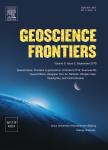Fluid-induced high-temperature metasomatism at Rundv?gshetta in the Lützow-Holm Complex, East Antarctica: Implications for the role of brine during granulite formation
Fluid-induced high-temperature metasomatism at Rundv?gshetta in the Lützow-Holm Complex, East Antarctica: Implications for the role of brine during granulite formation作者机构:Graduate School of Life and Environmental SciencesUniversity of TsukubaIbaraki 305-8572Japan Department of GeologyUniversity of JohannesburgAuckland Park 2006South Africa Department of GeologyChukwuemeka Odumegwu Ojukwu UniversityUliNigeria
出 版 物:《Geoscience Frontiers》 (地学前缘(英文版))
年 卷 期:2018年第9卷第5期
页 面:1309-1323页
核心收录:
学科分类:0709[理学-地质学] 07[理学] 070901[理学-矿物学、岩石学、矿床学] 0708[理学-地球物理学] 0704[理学-天文学]
基 金:Partial funding for this project was produced by a Grant-in-Aid for Scientific Research (B) from Japan Society for the Promotion of Science (JSPS) (No. 26302009) the NIPR General Collaboration Projects (No. 2634) to Tsunogae
主 题:High-temperature metasomatism Brine Phase equilibrium modeling Fluid inclusion Gondwana Lützow-Holm Complex
摘 要:We report new petrological, phase equilibria modeling, and fluid inclusion data for pelitic and mafic granulites from Rundv?gshetta in the highest-grade region of the Neoproterozoic Lützow-Holm Complex(LHC),East Antarctica, and provide unequivocal evidence for fluid-rock interaction and high-temperature metasomatism in the presence of brine fluid. The studied locality is composed dominantly of well-foliated pelitic granulite(K-feldspar+quartz+sillimanite+garnet+ilmenite) with foliation-parallel bands and/or layers of mafic granulite(plagioclase+orthopyroxene+garnet+ilmenite+quartz+biotite). The boundary between the two lithologies is defined by thin(about 1 -20 cm in thick) garnet-rich layers with a common mineral assemblage of garnet+plagioclase+quartz+ilmenite+biotite ? orthopyroxene. Systematic increase of grossular and decrease of pyrope contents in garnet as well as decreasing Mg/(Fe+Mg) ratio of biotite from the pelitic granulite to garnet-rich rock and mafic granulite suggest that the garnet-rich layer was formed by metasomatic interaction between the two granulite lithologies. Phase equilibria modeling in the system NCKFMASHTO demonstrates that the metasomatism took place at 850 -860℃, which is slightly lower than the peak metamorphism of this region, and the modal abundance of garnet is the highest along the metapeliteemetabasite boundary(up to 40%), which is consistent with the field and thin section observations. The occurrence of brine(7.0 -10.9 wt.% Na Cleqfor ice melting or 25.1 -25.5 wt.% NaC leqfor hydrohalite melting) fluid inclusions as a primary phase trapped within plagioclase in the garnet-rich layer and the occurrence of Cl-rich biotite(Cl = 0.22 -0.60 wt.%) in the metasomatic rock compared to that in pelitic(0.15 -0.24 wt.%) and mafic(0.06-0.13 wt.%) granulites suggest infiltration of brine fluid could have given rise to the high-temperature metasomatism. The fluid might have been derived from external sources possibly related to the formation of major suture zones formed during the Gondwana amalgamation.



